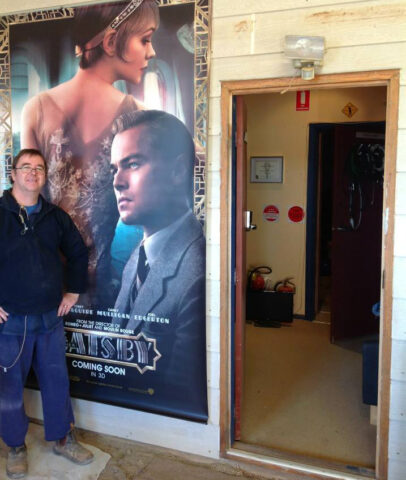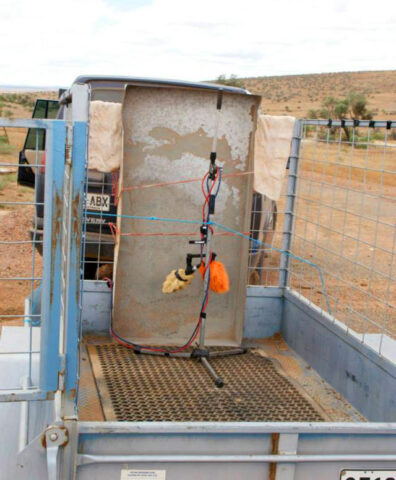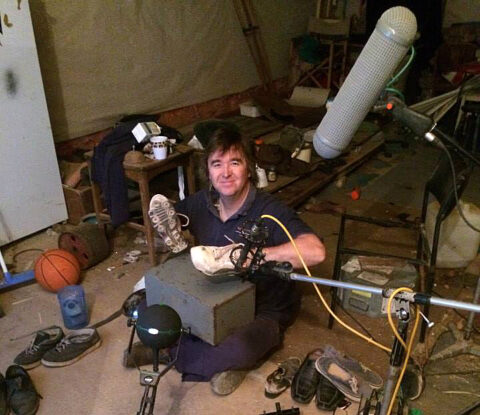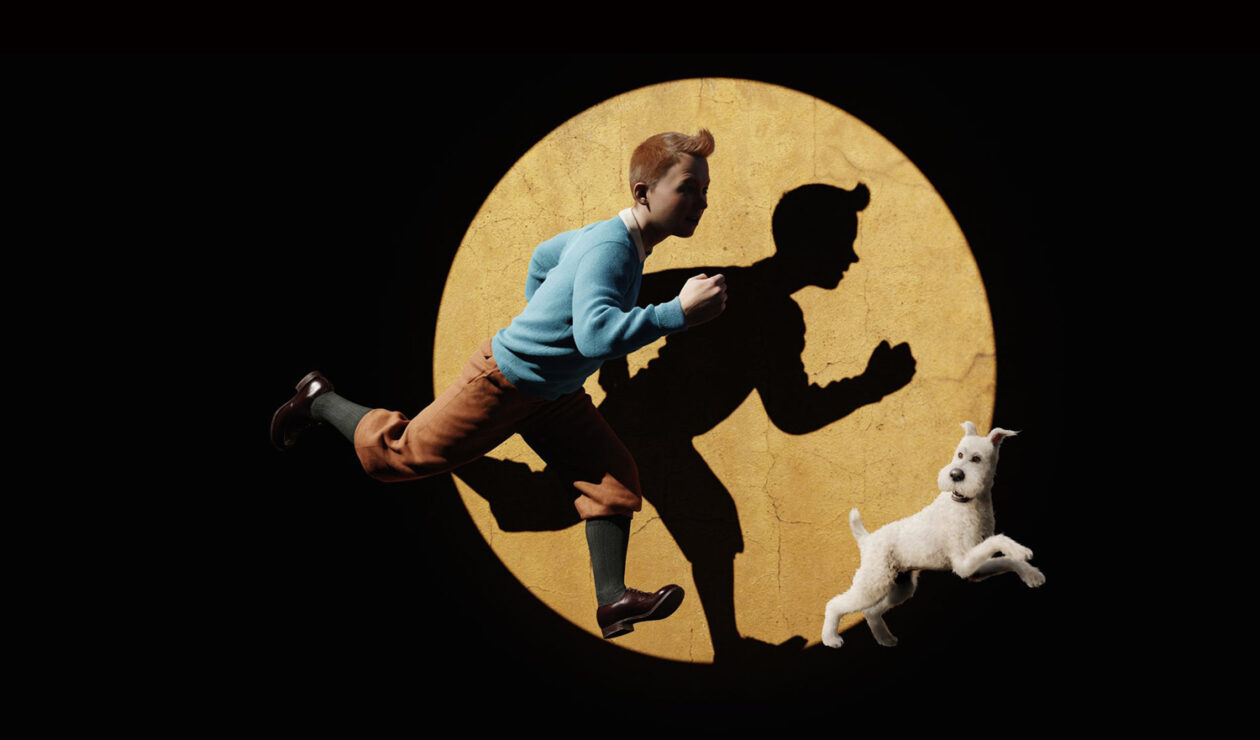John Simpson is a man who experiences the world through sound.
The 59-year-old is a Foley artist, which means he makes the sounds of everyday movement in movies and television shows. Foley – named after the man who developed it, Jack Foley – is not special effects, but rather the re-creation of noises such as gravel crunching underfoot, a saddle squeaking as an actor gets on a horse, the smash of a plate as it hits the floor.
Simpson creates these effects in post-production, so he watches the on-screen action and makes the sounds in sync with what he sees. And after more than 40 years working in the field, he is wired for sound.
“I’m always listening to everything in the street,” he says. “I’ll hear some shoes, and I’ll turn around and see what they are and think they sound nice and then I’ll try to find some.
“Most of my stuff comes from op shops – it’s the greatest place for me for things like knives and forks and plates, because unfortunately, these things I need to break, so you have to buy $2 plates. I also get handbags, jewellery and all those bits and pieces that anyone picks up and wears and moves; it all gets re-recorded.”

Foley artist John Simpson in his Quorn shed.
The Foley expert has worked on many major productions in the past few decades, including The Lighthorsemen, Storm Boy, Portrait of a Lady, The Truman Show, The World’s Fastest Indian and Mad Max: Fury Road. In between the big feature films, his regular television work includes Neighbours, for which he has recorded thousands of hours of sound.
For the past 20 years, Simpson has worked out of a large nondescript shed in the middle of nowhere, near Quorn in the Flinders Ranges.
The 20m by 12m structure rises out of the red dirt and looks unremarkable. But inside this shed is 40 years’ worth of collected sound paraphernalia, stored somewhat haphazardly in a curated mess. His recording studio is contained in a separate, soundproof part of the shed: a small shed within a shed.
Seatbelts that click, jewellery that chinks, phones that flip shut, taps that squeak, reins that rattle – you name it, Simpson has it here.
“I don’t even know half the stuff I have because every time I do a clean-up I find things I forgot I had and I’ve probably bought it three times over,” he says. “But you basically have to have almost everything domestic, things that you might find in your house. There is a kitchen sink in here somewhere.”

This set-up shows how Simpson recorded the sound of gravel and dust hitting metal to simulate the sandstorm sounds from inside a vehicle on Mad Max: Fury Road.
Some of Simpson’s favourite pieces include a squeaky car which is actually a money box.
“The wheels squeak every time,” he says. “I bought it in a junk shop in New Zealand when I was doing The Hobbit.
“I’ve also got an old, rusty hinge which makes a great noise, plus all sorts of mobile phones, including flippy ones. In the old days, when I started, there was no such thing as a mobile phone; now everyone has one in their hand and they are continually moving them from left to right and putting them in their pockets, so it’s very time-consuming.”
He says he has been passionate about film since he did work experience in 1979, then aged 15, on the set of a television show called Torque, presented by then-well-known TV personality Peter Wherrett.
On that shoot, Simpson met a sound recordist called James Currie, who let the young student listen to the recorded sounds through his headphones.
“That was it – I just got an absolute bug for sound,” he says. “I just loved what you could hear and where the microphones were placed and what they picked up.
“I knew I wanted to be involved in the sound side of things from then on.”
Simpson – whose father David was a photographer and mother Pat a former Fleet Street journalist in London – left Scotch College to take up a full-time position at the SA Film Corporation as an assistant projectionist, just to get his foot in the door.
“As soon as I got that job I thought, ‘I’m in’, and here I am, still in the industry all these years later.”
In the early days, Simpson worked through the SA Film Corporation in sound, as well as freelancing in Sydney and Melbourne for big television companies such as Crawford Productions.
He ended up in Quorn because that’s where his ex-wife’s parents were running a caravan park, but he says he’s always been someone who was drawn to rural life.
“The fact that I can actually live and work here, it’s just the ultimate. I’m not someone who really likes a city; I can tolerate it but I just crave the fresh air and the space. I’m not good with crowds.”

John Simpson creating the different sounds of shoes.
Some of his favourite productions have included The Adventures of Tintin (2011), directed by Steven Spielberg and produced by Peter Jackson.
“You just don’t get too many more powerful industry people to work for; that was the pinnacle of my career, really,” he says.
Working as a Foley artist is demanding – a half-hour television show can take a day to complete and a movie will take 80 to 120 hours, depending on how many people are involved and how much action there is.
An animation is even more gruelling, says Simpson, adding: “We work on the idea that every five minutes of animation takes an hour to do. For the film Happy Feet, that was 500 hours, plus 1000 hours of editing for all the dancing.”

Simpson has worked on comedy series Fisk and is currently creating Foley for its new season. Photo: ABC
It can feel monotonous – “conveyor belt”, as Simpson describes it – so to break things up, he has also set up his own sound company, Outback PA Hire, supplying and setting up sound equipment for music festivals.
“It gets me out of the studio and gives me a break. You’ve got to have a life.”

Get InReview in your inbox – free each Saturday. Local arts and culture – covered.
Thanks for signing up to the InReview newsletter.
The hardest sounds to create are those that don’t exist yet – something from a science-fiction film which necessitates coming up with an original and creative effect.
Simpson says there is an art to what he does, being able to walk in the style of the person on the screen, maybe with a slight shuffle or limp, having an eye for detail and making sure you don’t miss anything in the action.
“And you also need a good sense of rhythm to be able to follow someone’s timing. And you need a lot of patience.”
Simpson is currently working on the new series of ABC comedy Fisk, which launches on October 20, and a new film called Pasa Faho. His next big project will be another Lord of the Rings film, slated for 2026.
Support local arts journalism
Your support will help us continue the important work of InReview in publishing free professional journalism that celebrates, interrogates and amplifies arts and culture in South Australia.
Donate Here




